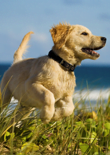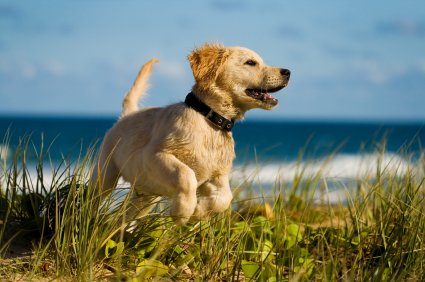The Best Way to Train a Puppy – Positive Reinforcement
By Sally Gutteridge | Posts

 Training a puppy can feel like the most difficult thing in the world to do. Advice from dog training professionals can sometimes seem conflicting and a new puppy owner can easily feel that they have no idea which is the right way to train their young dog. Are you a new puppy owner that would like to know the best and most effective way to train your new family member to behave nicely?
Training a puppy can feel like the most difficult thing in the world to do. Advice from dog training professionals can sometimes seem conflicting and a new puppy owner can easily feel that they have no idea which is the right way to train their young dog. Are you a new puppy owner that would like to know the best and most effective way to train your new family member to behave nicely?
Positive reinforcement is the only effective, kind and long term dog training technique that your puppy will truly enjoy. The theory behind this type of training is that you always reinforce a behavior that you would like your puppy to repeat and ignore each action that you would prefer your puppy to leave behind. Many professional dog trainers use positive reinforcement to train older dogs that are going to carry out a role of employment such as assist a disabled person or search for an item.
Here I will explain how simple it is to use reinforcement by providing a positive result to a behavior offered by your puppy. This training ethic is a way of molding your puppy into a dog who behaves in a way that is useful to you and healthy for him. It is also great fun to carry out. Read on to discover how easy and enjoyable it is to train your puppy using positive reinforcement.
Toilet Training
Never punish your puppy if he has an accident in the home. He has simply not learned yet where he should go to “perform”. Offer him plenty of opportunity to toilet outside, observe throughout and then when he does toilet outdoors reward the action with plenty of praise and a game or treat.
A young dog wants to please you. They like the result that your pleasure provides, which is praise and a reward. Therefore by showing your dog that you are over the moon with his action of toileting outdoors you will trigger something in him that makes him want to repeat the action. It won’t happen overnight but by repeating this over a few days you will be using positive reinforcement to toilet train your puppy.
Come when called
A young puppy is not designed to run away. Dogs prefer to be near other creatures and this includes human beings. Recall problems occur when the environment is more interesting that the person doing the calling. Positive reinforcement when used as a technique for training recall is easy. Always reward the puppy when he returns to you. Be an interesting and worthwhile prospect. You can also vary your tone of voice to grab the attention of your puppy; anyone that has worked with puppies will confirm the effectiveness of “puppy, puppy, puppy” delivered in a high pitch to get a litter of puppies racing towards them.
By offering a bonus for a prompt and keen return to you then you are reinforcing a good recall. Think of it this way, the dog will choose the most gratifying option to himself. So make yourself and the treats/toys that you carry reward enough to overcome any distraction then ensure that the reward is sufficient to bring him running back next time you call.
Ignore the unhelpful behavior
One of the most important rules when training your puppy with positive reinforcement is that you do not inadvertently reinforce unhelpful behavior. If your puppy is offering a behavior that is, or could develop into a problem you can make this behavior extinct by simply ignoring it. For example if a dog that is jumping up for attention, is then picked up into the arms of his target, he has just been taught to jump up. Which is cute behavior from a 2kg puppy but not so welcome from a 40kg Labrador.
Ignoring the unhelpful act and offering a favorable reward for the behavior that you would like repeated is a useful way to mold a nicely behaved puppy. As an intelligent creature, your young dog will soon learn that he gets the best result from certain actions then strive to achieve the result again and again.
Check out Jean Cote’s new obedience training program which utilizes positive reinforcement as a way to train your dog in everyday good behavior and to teach him fun actions along the way.
Session expired
Please log in again. The login page will open in a new tab. After logging in you can close it and return to this page.
I totally agree, positive reinforcement is the way to go.
Negative reinforcement, just seems to punish dogs and leave them with a sour taste in their mouths.
My boyfriend and I are trying to train our new puppy using positive reinforcement but it is very difficult. .I understand that you reward him when he does good things and ignore him when he does not good things. but what if you want him to do something and he will not do it? He wont walk through doorways, get in the car, pee/poo outside, or go in his kennel..no matter what we do. Treats, praise, and “good boy” are not working. We have to pick him up and put him in his kennel. He has no idea what’s going on. I’m brand new at this. He just wont do what we want him to do and it is very frustrating and it’s making me late for work all the time and real mad. I need Help! 🙁
Hi,
The thing about positive reinforcement training is that it takes a little bit of time to get the hang of it and for your dog to learn what you want him to do. I think you need to reward partial behaviors instead. Don’t wait until your dog goes through a doorway before rewarding him, reward him for getting close to it first, and gradually hold back on the reward until your dog gets closer and closer. 🙂
hi. im not sure where to start i have a 3 month old lab,chow,makish,and german shepard mixed puppy…. its not that he is bad but i think he is confused we take him outside and he will potty we tell him good boy but then he turns around and pottys in the house… when we take him for walks he jumps on everyone no matter if we tell him bad or no he still dose it no matter what.. any suggestions :,(